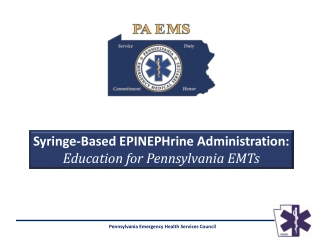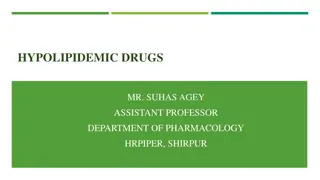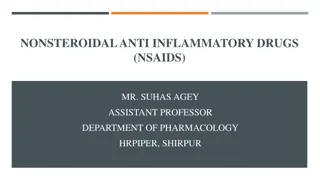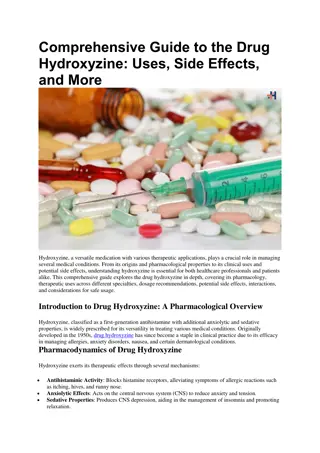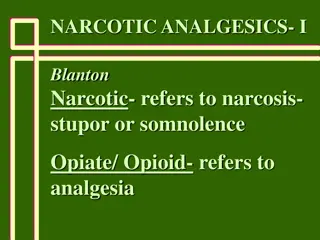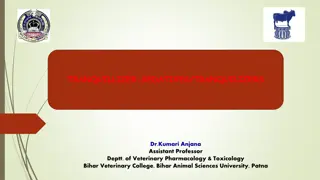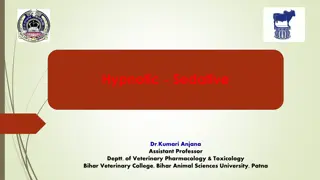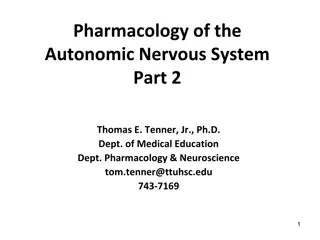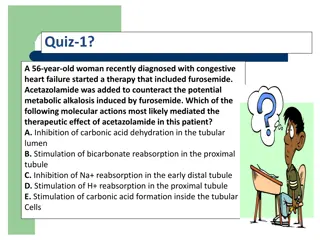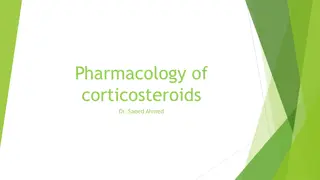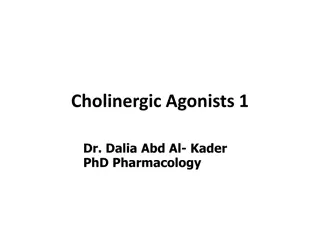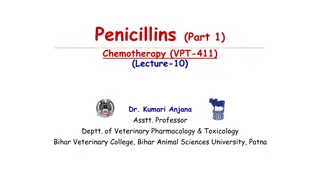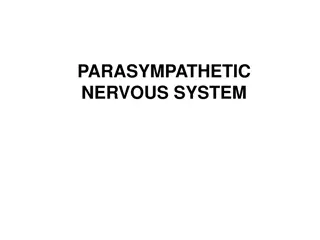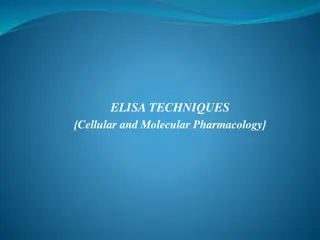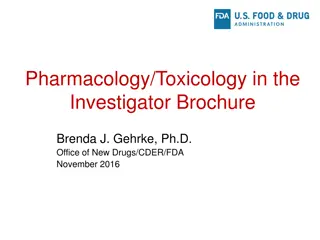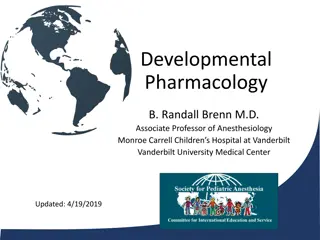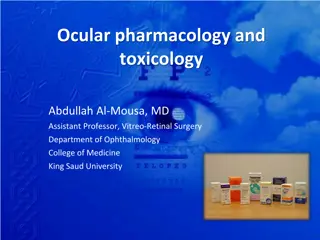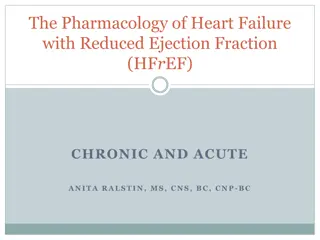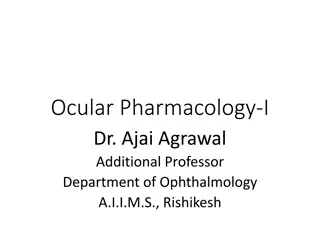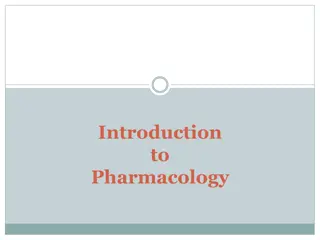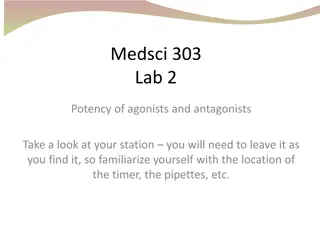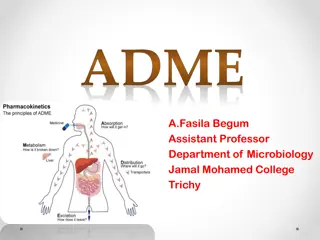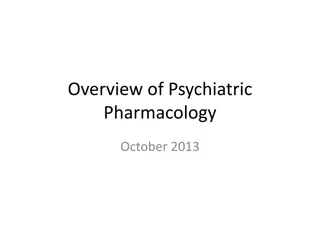Syringe-Based EPINEPHrine Administration Education in Pennsylvania
The Pennsylvania Emergency Health Services Council is promoting syringe-based EPINEPHrine administration for EMTs as a cost-effective and safe alternative to auto-injectors. This initiative aims to educate on anaphylaxis pathophysiology, EPINEPHrine pharmacology, and safe medication practices while
0 views • 34 slides
Understanding Adrenergic Agents in Pharmaceutical Chemistry
Adrenergic agents play a crucial role in pharmacology by influencing the sympathetic nervous system through adrenergic receptors. These agents, such as sympathomimetics and sympatholytics, impact essential functions like cardiac activity, blood vessel dilation, and insulin release. Adrenergic neurot
0 views • 120 slides
Understanding Posology in Pharmacology: Factors Affecting Drug Dosage
Posology, the science of determining drug dosage, is influenced by various factors including age, sex, body weight, route of administration, and more. Changes in pharmacokinetics with age, differing drug responses in men and women, and the importance of body weight in dosing are crucial consideratio
6 views • 23 slides
Understanding Pharmacokinetics in Clinical Pharmacology
Pharmacokinetics, as explained in a lecture by Oula Mohammed Sami, M.B.Ch.B/MSc in clinical pharmacology, delves into how the body processes drugs, contrasting with pharmacodynamics which focuses on drug actions. Key topics covered include properties influencing treatment outcomes, the significance
6 views • 45 slides
Understanding Hypothalamus and Pituitary Hormones in Clinical Pharmacology
Peptides and glycoproteins are secreted by the hypothalamus and pituitary, regulating anterior pituitary hormones. Hormones like adrenocorticotropic hormone (ACTH) and corticotropin-releasing hormone (CRH) play crucial roles. Synthetic adrenocorticosteroids have limited the use of corticotropin for
1 views • 28 slides
Historical Development and Principles of Pharmacology
Explore the historical roots of pharmacology from ancient civilizations like India, China, and Egypt. Learn about the development and principles of drug activity, including pharmacokinetics and pharmacodynamics. Discover early medicinal practices and the evolution of drug administration. Gain insigh
2 views • 50 slides
HYPOLIPIDEMIC DRUGS
Major lipids like cholesterol and triglycerides play essential roles in the body, but their excess can lead to hyperlipidemia and related conditions. This overview covers the biosynthesis of cholesterol, triglycerides, and the transport of lipids in the bloodstream, discussing the importance of lipo
1 views • 30 slides
Understanding Nonsteroidal Anti-Inflammatory Drugs (NSAIDs) and Their Pharmacology
Nonsteroidal anti-inflammatory drugs (NSAIDs) are a class of analgesic, antipyretic, and anti-inflammatory medications that work by inhibiting prostaglandin synthesis. They provide relief from pain, reduce fever, and combat inflammation through various mechanisms. Aspirin, a commonly used NSAID, irr
0 views • 21 slides
Comprehensive Guide to the Drug Hydroxyzine
This comprehensive guide explores the drug hydroxyzine in depth, covering its pharmacology, therapeutic uses across different specialties, dosage recommendations, potential side effects, interactions, and considerations for safe usage.
0 views • 6 slides
Understanding Narcotic Analgesics and Opiates: History, Mechanisms, and Uses
Delve into the world of narcotic analgesics and opiates, exploring the history of opium poppy, morphine derivatives, opioid compounds, and the pharmacology mechanisms of action. Discover the uses of opiates in analgesia, preanesthetic medication, and more, alongside the endogenous ligands involved.
8 views • 55 slides
Understanding Histamine and Antihistaminics: A Comprehensive Overview
Histamine is a vital autacoid synthesized and stored in mast cells, playing a key role in various physiological processes and allergic reactions. This article delves into its synthesis, storage, release, and receptors like H1, H2, and H3, along with the pharmacology of antihistamines. Explore the in
0 views • 24 slides
Overview of Tranquillizer-Sedatives in Veterinary Pharmacology
Tranquillizer-sedatives are drugs used in veterinary medicine to reduce mental tension, induce calmness, and manage behavioral disorders in animals. The chapter covers the classification, therapeutic uses, mechanisms of action, and adverse effects of various tranquillizer groups such as phenothiazin
0 views • 26 slides
Overview of Sedatives and Hypnotics in Veterinary Pharmacology
This chapter discusses the classification, salient features, and uses of sedatives and hypnotics in veterinary pharmacology. Sedatives subdue excitement and induce calmness without necessarily causing sleep, while hypnotics induce and maintain sleep. Both classes of drugs act as CNS depressants and
1 views • 23 slides
Appetite Stimulants, Digestants, and Carminatives in Pharmacology III
Appetite is influenced by various factors including hypothalamic peptides, catecholaminergic pathways, and serotoninergic signaling. Loss of appetite, like anorexia, can stem from both physical and psychological causes. Alcohol can stimulate gastric secretion but chronic consumption may reduce appet
0 views • 8 slides
Pharmacology of the Autonomic Nervous System Part 2 Summary and Learning Objectives
Explore the pharmacology of the autonomic nervous system focusing on cholinergic and adrenergic agents. Learn about cholinomimetics, direct and indirect acting cholinergic agonists, their therapeutic indications, and adverse effects. Discover the mechanism of action and uses of nicotinic agonists. D
2 views • 44 slides
Pharmacology Quizzes on Diuretics and Their Clinical Applications
This content presents a series of quizzes involving diuretics and their role in clinical scenarios related to heart failure, glaucoma, renal hemodynamics, and intracranial pressure. Questions cover various diuretic agents such as furosemide, acetazolamide, mannitol, and hydrochlorothiazide, focusing
0 views • 10 slides
Complexity in Cancer Pain Management by Dr. Marie Joseph
Dr. Marie Joseph explores the challenges and successes of managing complex pain in cancer patients. The intricacies of neuropathic pain, diagnostic characteristics, pathophysiology, pharmacology, and typical cancer pain syndromes are discussed. Strategies such as co-analgesic adjuvants, analgesic sy
0 views • 12 slides
Renal Pharmacology: Drug Excretion and Renal Clearance Questions
This comprehensive set of questions and answers covers topics related to drug excretion and renal pharmacology. It includes information on glomerular filtration, drug excretion mechanisms, dosage adjustments in renal impairment, factors influencing drug excretion, and the effects of long-term NSAID
0 views • 55 slides
Overview of Cephalosporins in Veterinary Pharmacology
Cephalosporins are a group of semisynthetic antibiotics derived from cephalosporin C obtained from a fungus. This chapter covers the introduction, chemistry, properties, solubility, classification, spectrum of activity, mechanism of action, applications, and side effects of cephalosporins. They offe
2 views • 29 slides
Understanding Pharmacology of Corticosteroids by Dr. Saeed Ahmed
Corticosteroids are steroid hormones produced by the adrenal cortex, classified into glucocorticoids and mineralocorticoids. Glucocorticoids have diverse effects on metabolism, immune responses, and inflammation, whereas mineralocorticoids regulate electrolyte balance. Mechanistically, corticosteroi
1 views • 32 slides
Understanding Routes of Drug Administration in Fish Pharmacology
Fish pharmacology is crucial for treating fish diseases effectively using drugs. Factors like water quality, pathogens, mortality rate, legal aspects, and economics need consideration. Different routes of drug administration in fish include water medication, immersion or dipping, hyperosmotic infilt
1 views • 20 slides
Understanding Neurohumoural Transmission in Veterinary Pharmacology
Neurohumoural transmission in the field of veterinary pharmacology involves the communication of nerve messages through the release of chemical messengers. This process includes axonal conduction and junctional transmission. The historical aspects of neurohumoural transmission highlight key discover
5 views • 11 slides
Understanding Cholinergic Neurons and Agonists in Pharmacology
Cholinergic neurons play a vital role in neurotransmission by utilizing acetylcholine (ACh) as a neurotransmitter. This neurotransmission involves steps like synthesis, storage in vesicles, release, receptor binding, degradation, and recycling of choline and acetate. Choline acetyltransferase cataly
0 views • 30 slides
History and Use of Penicillins in Veterinary Pharmacology
Penicillins, the first beta-lactam drugs discovered by Alexander Fleming, play a crucial role in combating bacterial infections. With a rich history dating back to 1928, these antibiotics revolutionized healthcare during World War II, significantly reducing mortality rates from infectious diseases.
0 views • 18 slides
Overview of Non-Steroidal Anti-Inflammatory Drugs (NSAIDs) in Veterinary Pharmacology
Non-steroidal anti-inflammatory drugs (NSAIDs) are a diverse group of medications with analgesic, anti-inflammatory, and antipyretic effects. They act primarily on peripheral pain mechanisms and have limited CNS effects. NSAIDs have a long history dating back to the use of White Willow bark, and the
0 views • 16 slides
Understanding Respiratory System Pharmacology and Cough Physiology
The regulation of respiration involves sensory and efferent pathways, with afferent pathways comprising stretch receptors, C-fibres, and irritant receptors, while efferent pathways include parasympathetic and sympathetic nerves. Cough physiology is a protective reflex initiated by various stimuli to
2 views • 43 slides
Pharmacology of Ovulation-Inducing Drugs
Understanding the mechanism of ovulation and hormonal regulation is key in classifying drugs used to induce ovulation. This lecture covers the pharmacology of different groups of drugs, their mechanisms of action, administration protocols, indications, efficacy rates, and adverse effects. Antiestrog
0 views • 6 slides
Understanding the Parasympathetic Nervous System and Cholinergic Pharmacology
Dive into the world of the parasympathetic nervous system and cholinergic pharmacology, exploring concepts like cholinomimetics, parasympathomimetics, cholinolytics, and more. Discover how acetylcholine synthesis and degradation play crucial roles in these processes, and learn about different cholin
1 views • 27 slides
Understanding ELISA Techniques in Cellular and Molecular Pharmacology
ELISA (Enzyme-Linked Immunosorbent Assay) is a vital immunological technique used in detecting antigens or antibodies in samples. This article covers the types of ELISA tests, such as Direct, Indirect, and Sandwich, along with the principles and applications of ELISA in diagnosis. The process involv
0 views • 18 slides
Student Perspectives on Learning Pathology and Pharmacology in Veterinary Medicine
Explore student experiences in learning tricky concepts in pathology and pharmacology as part of a veterinary medicine program. Discover challenges faced, valuable resources created, and the importance of student perspectives in enhancing learning outcomes.
0 views • 21 slides
Understanding Pharmacology and Toxicology in Investigator Brochures
Explore the essential aspects of pharmacology and toxicology covered in Investigator Brochures, including nonclinical information, safety pharmacology, general toxicology, genetic toxicology, and more. Learn about the significance of pharmacology in predicting intended and unintended effects, consid
1 views • 40 slides
Pediatric Pharmacology Considerations and Challenges
Developmental pharmacology in children involves unique considerations such as drug metabolism, urine concentration, and muscle relaxant dosing. The field faces challenges with limited drug testing in pediatric populations, emphasizing the importance of age-appropriate pharmacotherapy. Factors like d
0 views • 39 slides
Understanding Ocular Pharmacology: General Principles and Drug Delivery
The study of ocular pharmacology involves understanding general pharmacological principles, pharmacodynamics, and pharmacokinetics. Drugs can be delivered to ocular tissue locally via eye drops, ointments, injections, or systemically through oral or intravenous routes. Factors such as drug concentra
0 views • 58 slides
Pharmacology of Heart Failure with Reduced Ejection Fraction (HFrEF)
Understanding the pharmacology of heart failure with reduced ejection fraction is crucial as it impacts millions of Americans and poses significant healthcare costs. The complex pathophysiology involves mechanisms like the Frank-Starling mechanism, alterations in myocyte regeneration, neurohumoral s
0 views • 44 slides
Understanding Ocular Pharmacology - An Overview by Dr. Ajai Agrawal
Explore the intricate world of ocular pharmacology with Dr. Ajai Agrawal, an Additional Professor at A.I.I.M.S., Rishikesh. The learning objectives cover pharmacokinetics, pharmacodynamics, and various routes of drug administration in ocular treatments. Delve into the anatomy of the eye, tear film c
0 views • 51 slides
Exploring the Fascinating World of Pharmacology: From Historical Developments to Basic Principles
Uncover the rich history of pharmacology from ancient civilizations to modern times, tracing the origins of medicinal practices and the development of drug-related concepts. Delve into the fundamental areas of pharmacology, including pharmacokinetics and pharmacodynamics, to understand the mechanism
0 views • 50 slides
Pharmacology Lab Equipment and Safety Guidelines
Explore the setup and procedures of a Pharmacology lab focusing on agonists and antagonists potency testing. Learn about equipment, tissue suspension, lab safety, lab plan, and health precautions. Follow instructions for conducting experiments, recording data, and cleaning up. Utilize resources prov
0 views • 28 slides
Understanding ADME in Pharmacokinetics and Pharmacology
Pharmacokinetics and pharmacology, focused on ADME processes, play a crucial role in drug development and delivery. Absorption, distribution, metabolism, and excretion determine how drugs interact within the body. Absorption involves transfer into the bloodstream, while distribution entails the spre
0 views • 12 slides
Overview of Psychiatric Pharmacology: A Comprehensive Guide from 2013
This presentation delves into the nuances of psychiatric pharmacology, exploring common psychiatric conditions, historical perspectives on medical treatments, categories of psychiatric medications, and principles of treatment. It also touches on mental illness definitions from DSM-IV-TR and DSM-V, a
0 views • 27 slides
Understanding Dose-Response Curves in Pharmacology
Dose-response curves play a crucial role in pharmacology by illustrating the relationship between drug dosage and its effects. Researchers use these curves to determine potency, efficacy, and safety of drugs, helping to establish the required dose for desired outcomes. By comparing pharmacologic pro
0 views • 13 slides
